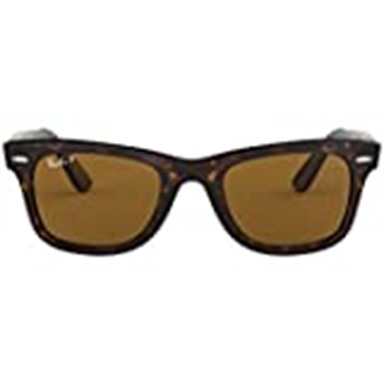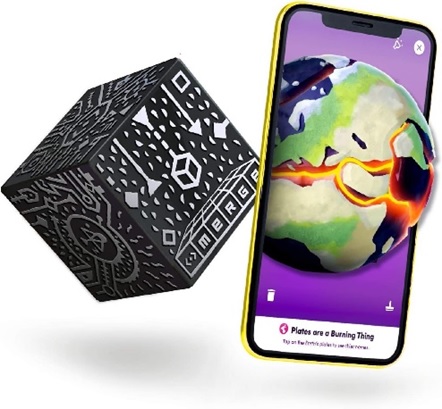
The latest augmented reality devices are altering how we interact with our surroundings. These devices can see digital information superimposed on real-world images. They can range from GPS navigation to social media notifications. Augmented reality devices have the potential to revolutionize the way we live, work, and play. This article will cover everything you need to know about augmented reality devices and the top 10 on the market today.
What is Augmented Reality?
Augmented reality is a technology that takes digital or artificial content and blends it with a person’s perception of the real world. You’ll often hear this technology referred to as AR. Just like virtual reality, which is usually written as VR, is the removal of all aspects of the natural world and replacement with synthetic elements, AR is the opposite. AR adds digital content to a person’s natural environment. Augmented reality adds pixels to your vision.
Table of Contents
Types of Augmented Reality devices
In terms of use cases, there are four types of AR devices accessible right now:
- Heads-up displays (HUD)
- Holographics displays
- Smart Glasses, and
- Handheld
Heads-up displays (HUD)
You’ve probably seen heads-up displays (HUDs) in action movies where the protagonist uses crazy gadgets and technology. HUDs are becoming more and more commonplace in the real world, too. You might already have one in your car! HUDs are a type of display that projects information onto a transparent screen in your field of view. You can see the information without having to look away from what you’re doing. They work for a variety of purposes, from gaming to navigation. Let’s look at the top three HUDs in the market today.
The Best Car Heads-up Displays (HUD):
Car heads-up displays, or HUDs, are an increasingly popular feature in new vehicles. HUDs project information onto the windshield so drivers can keep their eyes on the road. Many HUDs display navigation information, vehicle speed, and other data. Some even allow drivers to control infotainment features without taking their hands off the wheel. If you’re in the market for a new car, you may wonder which HUD is right for you. In this article, we’ll give you a rundown of the best car HUDs on the market.
1. Hudway Drive
The Hudway Drive is our favorite car heads-up display. Although the $279 device is pricey, it has almost everything you could want in a heads-up display. Using data from the OBD port, GPS satellites, and your smartphone, every scrap of useful information — including turn-by-turn navigation — is available at a glance. However, it is quite large and may occasionally get in the way.
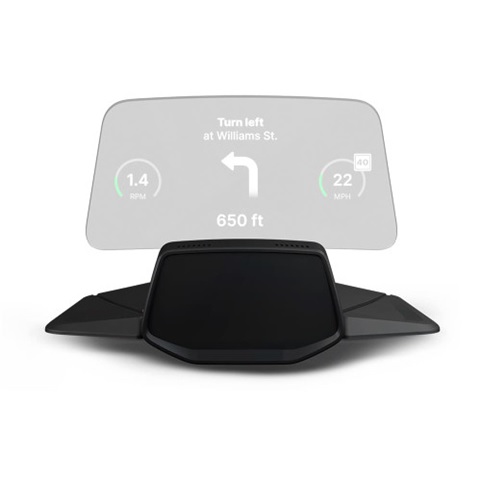
| SPECIFICATIONS | Size: 7.3 x 6.3 x 4.0 inches2 | Weight: 9.0 ounces3 |
Power: 12-volt accessory outlet | Display size: 1.8-inches | |
Color/Monochrome: Color | Number of parameters displayed: 11 | |
Alarms: Yes |
Best Features:
- There is no need for power or cables to function.
- A fantastic view that is best in low-light conditions (rain, fog, darkness).
- The high-quality lens produces sharp reflections, while the transparency allows for a clear road view.
- Navigation is displayed directly in your line of sight.
Pros:
- Excellent value for money
- Simple to set up
- Looks great both day and night.
- Hudway apps are extremely useful.
Cons:
- There is little to no visibility in daylight.
- Magnetic mounts used to come apart if you have the early versions.
If that price tag for the Hudway Drive is too high for you, the Pyle PHUD180BD offers a lot for only $83.99. The 5.5-inch super-bright screen can display up to 14 data points from your car’s OBD port and includes alarms for when something goes wrong.
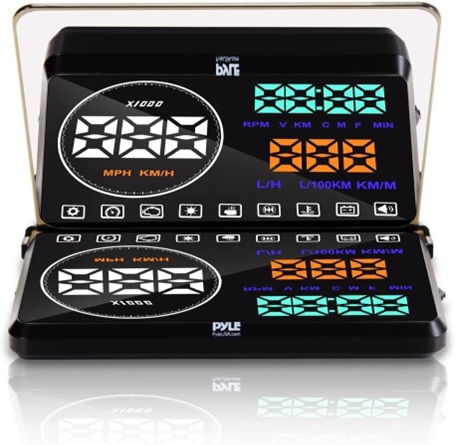
| SPECIFICATIONS | Size: 5.3 x 3.0 x 0.5 inches | Weight: 4.4 ounces |
Power: OBD2 port | Display size: 5.5-inches | |
Color/Monochrome: Color | Number of parameters displayed: 14 | |
Alarms: Yes | ||
| TODAY’S BEST DEALS | Check in Amazon | |
Best Features:
- Ultra-Clear, Digital Pop-Up Screen for Your Windshield with Heads-Up Display System and Vehicle Readout.
- Mounts to the dashboard for driving information projection.
- LED Display, 5.5″ Multi-Color.
Pros:
- Convenient Vehicle Data Displays
- Visibility of clear readouts while driving during the day or at night
- Light Sensors Integrated for Automatic Image Balance
Cons:
- It, like other projection HUDs, may exhibit a double image.
- It may take some time to calibrate the device properly, but it is rock solid once completed.
However, if you want something different that still combines OBD and GPS data, the Wiiyii Car HUD may be the one for you. It’s only $49.99 and has a visually appealing design and information that true gearheads will appreciate.
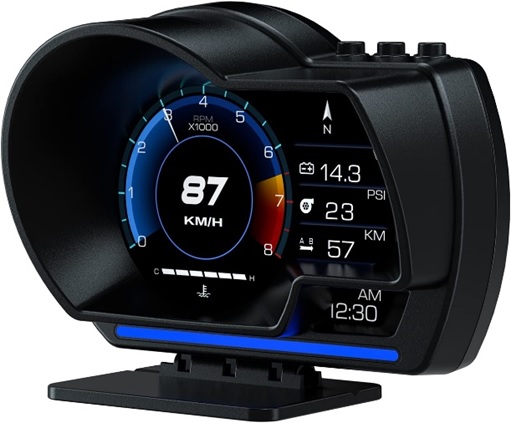
| SPECIFICATIONS | Size: 4.3 x 5.0 x 3.5 inches | Weight: 4.4 ounces |
Power: 12-volt accessory outlet | Display size: 1.8-inches | |
Color/Monochrome: Color | Number of parameters displayed: 15 | |
Alarms: Yes | ||
| TODAY’S BEST DEALS | Check in Amazon | |
Best Features:
- This gadget shows straight to you at any angle you place it; no effort is required to look.
- It comes with ten different interfaces, a free switch, an LCD meter, the ability to clear error codes and read data streams, two installation methods with adjustable brackets for mounting on the dashboard or sticking to the windshield, simple operation, and non-destructive installation.
- Common meters only have OBD mode, but this device has two modes: OBD+GPS 2-in-1, the default display OBD+GPS function simultaneously.
Pros:
- The display is really clear and bright, and it looks fantastic.
- The images in the listing are accurate.
- The installation process was rather simple.
- Reasonable cost
Cons:
- Some complain that reading is nearly impossible when in the bright sun.
The VGEBY HUD is a straightforward screen that can be fitted to any vehicle with an OBDII or EUOBD (On-Board Diagnostic System) priced at $47. The monitor itself is 5.5 inches in length and has a large number of indicator displays. You include the speedometer, the fuel usage, as well as the temperatures of the water, along with other indicators.
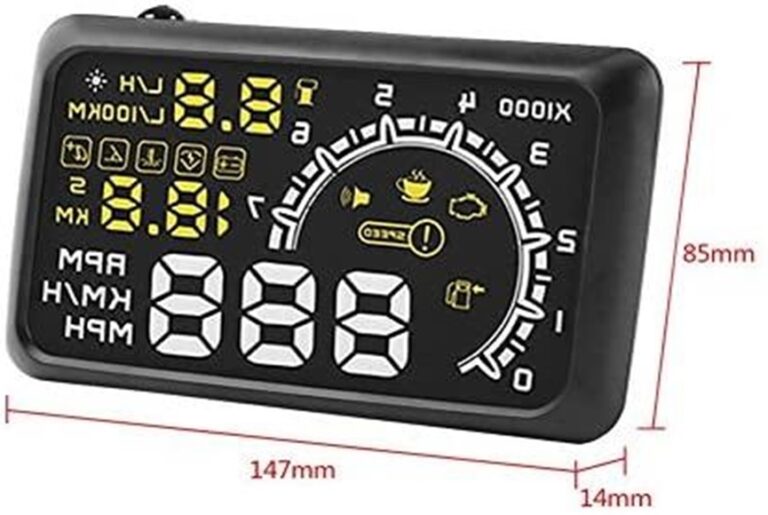
Best Features:
- An automated setting, which means it will turn on when you start your vehicle and stop automatically when it’s time to pull off the road.
- An engine sensor that will activate if you start to accelerate too quickly.
- Users can effortlessly switch between kilometers and miles.
Pros:
- Displaying data in a diverse way. The configurations for the driver’s display include automated, high-speed, and conventional modes.
- Attach and engage. HUD has automatic vehicle-type adaptation.
- This HUD can simultaneously display the following metrics: engine speed, water temperature, and vehicle speed.
Cons:
- Not compatible with some vehicles
Holographics displays
Holograms are three-dimensional images that project images into space without needing screens or other physical objects. When you see a hologram, you see the light manipulated to create the illusion of an object floating in mid-air. Holographic displays are becoming increasingly popular as they offer a more immersive experience than traditional screens.

In recent times there have been several hologram projectors in the market. Still, we have done the hard work of scrutinizing them to present the top three.
The new holographic projector brand Missyou is known for experimenting with cheaper yet creative alternative technologies.
Missyou Hologram Projector is laser-free. This holographic projector employs synchronized LED lights on a 16.5-inch blade spin. The LED lights’ rotation and synchronized movement create a 3D image with good depth.
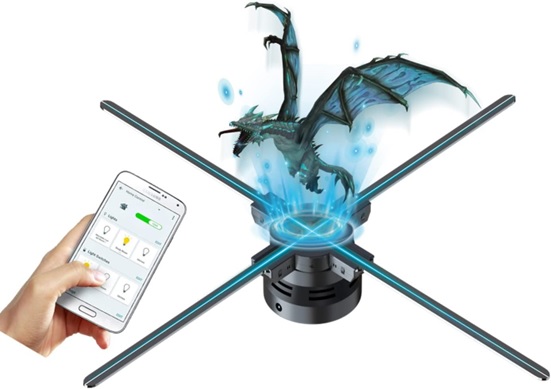
The hologram projector has a brightness of 5000 lumens. Custom image/video files are transferred using the TransFlash hardware interface with an adaptor powering the blades. This configuration is supported by a bracket attached to the wall mount base. The hologram projector uses 15 watts, and the price starts at $259.
Best Features:
- 5-inch revolving blade with 224 LEDs
- 5,000 lumens
- TransFlash interface
- 15 watts
Pros:
- Custom photos, videos, text rendering
- Wall-mountable
- 3-year replacement warranty
Cons:
- The spinning blade may be noisy.
The Spectre Hologram is a pocket-friendly holographic projector. It was customized to accommodate the human-eye viewing angles, resulting in a projecting prism. The four-face prism converts a screen into a projector, and the screen picture is mirrored onto prism faces. The angular slant of the faces generates 3D-looking image frames.
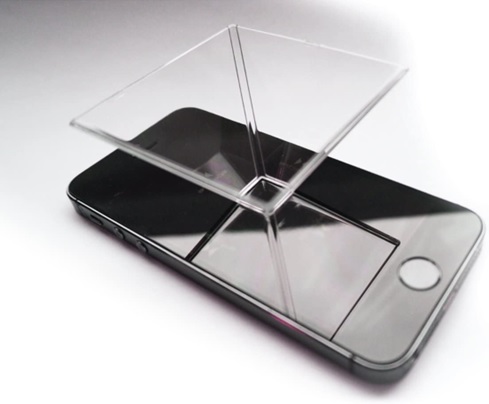
The prism is compatible with mobile phones and horizontal screens, and the construction of the Spectre hologram projector provides zero power. Polycarbonate makes the projector body impact resistant. You can get this item for around $10.49.
Best Features:
- Polycarbonate body
- Four clear faces for frame reproduction
- Widescreen support
Pros:
- The prism design is powerless.
- Color accuracy Easy installation and removal
Cons:
- Horizontal only
- Small prism faces produce small images.
Shenzhen Giwox Technology is another well-known brand. The brand supplies commercial projectors with strict quality development. The outcome is a high-performance projector with excellent visuals.
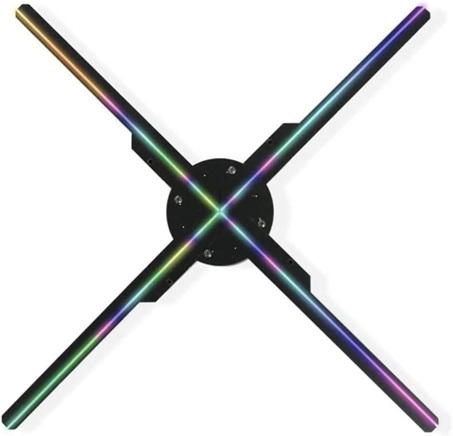
Giwox Hologram Projector has 19.7-inch blades, each having LEDs. High-speed blade rotation with synchronized LED on/off guarantees excellent 3D image/video reproduction. The LED setup’s brightness of over 3000 cd/m2 is noticeable in a well-lit environment.
Over 1600576 dpi creates a crisper, HD image. A smartphone app controls the projector’s brightness, file sharing, and other options. MicroSD cards are supported for image/video sharing, and signal processing decodes all files. Price starts at $249.99
Best Features:
- 576 LED beads
- Four spinning blades
- Custom pictures, movies, and text files supported
- Supports MicroSD
- Over 3000 cd/m2
Pros:
- Comparatively high power usage
- App-controlled, wall-mountable
Cons:
- None built-in speaker
Advanced technologies, such as WiFi technology, are suitable with the ASHATA WiFi 3D projector. Undoubtedly, this holographic projector is among the greatest ones on the market right now. Rather than connecting to an external network, you can utilize your own computer server thanks to WiFi technology.
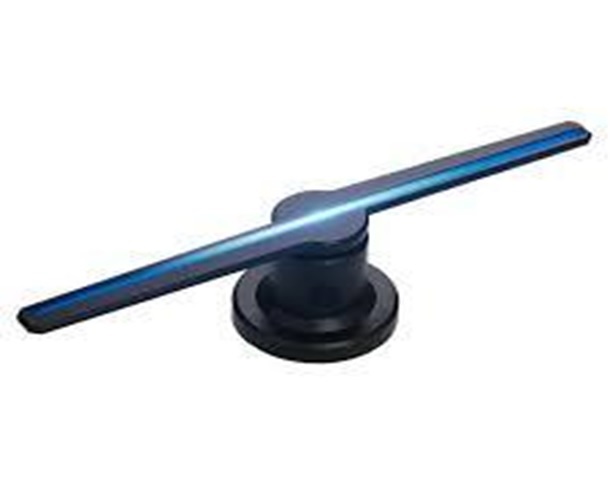
Best Features:
- A projection setup that features a television and an electronic projector on opposite sides.
- Ability to alter the colors to optimize your viewing experience.
- Versatility to 3D.
- There are many connections supported, and the playback screen is bigger and sharper.
Pros:
- Ability to work with different devices.
- Durable.
- Crystal-clear screen.
- Expansive field of vision
Cons:
- Minimal resolution.
- Only a few LEDs.
Smart Glasses
The idea of wearable technology has been around for centuries. Still, it was only in the last few decades that technology has advanced enough to make it a reality. In the past few years, there has been a surge in the development of smart glasses. These glasses have a built-in computer and display, and they can be used for various tasks, from navigation and information retrieval to gaming and entertainment. After rigorous scrutiny by tech experts, here are the best three smart glasses you can buy now.

Ray-Ban Stories look like regular sunglasses. They don’t scream ‘nerd’ when you put them on, which is a plus.
They come in five colors (glossy black, blue, brown, olive, or matte black) and six lens types (Meteor, Round, and Wayfarer) (brown gradient, clear, dark blue, dark gray, green, or photochromatic green). There are prescription lenses for those who want that benefit.
You can upload videos and photos taken with them via an app. However, you’ll need a Facebook account. It has an arm capture button and touch-sensitive surface control for calls, playback, and volume. Despite privacy concerns, these are the most feature-rich smart glasses available. While there’s no augmented reality display, Facebook plans to add one soon.
Best Features:
- Impressive design
- Quality calls
- Portable charging
- Microphone arrays
Pros:
- Comes in many styles, colors, and designs
- High-quality video
- Simple video and image uploading to social media
Cons:
- Basic photo editing features.
- Facebook Account is required.
Anzu Smart Glasses instantly connect to a paired device when opened. Each pair comes in two frame shapes and sizes and has blue light-filtering lenses and polarized sunglass replacement lenses. We found the arms large and the built-in speakers lacking, but the inexpensive pricing and extra features make up for it. Our experts like how you can use touch controls to reach your phone’s voice assistant.
Best Features:
- IPX4 water-resistant with one set of blue-light filtering and one set of polarized lenses
- Optional frame size and lens shape
- “Gamer mode” in-app for low-latency audio
Pros:
- Excellent blue-light filtering
- Great battery life
- When folded, the power goes out.
- Bluetooth connectivity of up to 60 meters
Cons:
Touch controls require some practice
The Bose Frames are sunglasses and headphones with the best audio quality on this list. They resemble regular sunglasses. Bose offers five styles of audio sunglasses: the Alto, Rondo, Tempo, Tenor, and Soprano. Choosing your style is fun.
The frames have speakers in arms behind the wearer’s ears. Even without in-ear headphones, the glasses design prevents sound leakage. You can enjoy music while staying alert (and without disturbing your neighbors).
Bose Frames include the Bose AR platform, which is still developing but shows promise for AR audio experiences. Built-in gyroscopes and motion tracking make the glasses ideal for augmented reality apps.
Best Features:
- Increased battery life
- Nylon framework
- Elegant high-gloss black finish
- Microphone Array with Dual Beam-Forming
Pros:
- Bluetooth range of up to 30 meters
- Battery life of 5.5 hours
- One hour to fully charge
Cons:
- There is no charging case.
- There is no camera.
Handheld AR
Handheld AR is one of the most exciting and talked-about technologies in recent years. While many people think of AR as only used in video games or for entertainment, the truth is that there are many potential applications for handheld AR in business and industry.

With augmented reality (AR) in the classroom, Merge Cube offers a creative and tactile learning method. Because it’s a real, solid thing that comes to life as a hologram when seen on a smartphone or tablet, it’s an incredibly useful learning tool.
MERGE Cube is an Augmented & Virtual Reality STEM toy with three components: an immersive headset, wireless controller & phone. It’s used to engage with the virtual world, take virtual selfies, and 3D-print a physical replica of a virtual thing. Because it substitutes pricey technology with a cell phone, this is a breakthrough for AR and VR.
Best Features:
- The Merge Cube is the only product that allows you to grasp digital 3D objects (holograms), offering a new method to learn STEM.
- Over 100 interactive science simulations children can touch, handle and interact with help students study effectively, anytime, anywhere.
- Students can upload, view, and share 3D creations on Merge Cube to uncover problems and iterate faster to develop better designs.
Pros:
- Immersive experience
- Great to bring STEM subjects to live
- Simple setup
Cons:
- Need to use a credit card before you can access free content
- Monthly subscription to access full resources.
Conclusion
Augmented reality devices are becoming more and more prevalent in the market. Different types of devices are available and can be used for a variety of purposes. Some of those purposes include enhancing the user’s real-life environments and allowing the user to see information transmitted from the device to their eyes for processing. For example, augmented reality devices can be used for activities such as agriculture, construction work, entertainment, transportation and more.
In the future, there will be even more types of augmented reality devices that we can use. Different companies will be trying to figure out the best possible uses of augmented reality technology and how to get people to use it. Companies like Google, Apple and Samsung will be a big part of those driving the action without leaving smaller and not-so-well-known companies behind.
So, if you’re looking to get into the world of Augmented Reality, you have a lot to expect this year and in the years to come.
